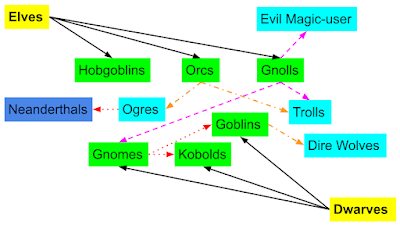Elf and dwarf PCs in BX D&D begin play speaking three monster languages each, as shown on the chart above using arrows with solid black lines. That means you are taking away a class ability if your campaign doesn't include those monsters (or, say some books or inscriptions written in their tongues).
The BX write-ups for four of these six monsters mention other monsters. These are the monsters in the blue boxes. The red arrows with the dotted lines indicates belligerence. The purple arrows with dashed lines indicates that these creatures figure into the gnolls' reputed origin story. The orange arrows with dashed and dotted line points to a buddy that sometimes hangs out with the monster.
It is my opinion that these relationships define the core monsters of a by-the-book BX campaign. Well, these folks plus the undead (so the cleric has something to turn).
An Old Conundrum
If dwarves "hate goblins, and will usually attack them on sight" (B35) and goblins "hate dwarves and will attack them on sight" (B36), then why does every dwarf PC start play fluent in goblish? This is a question I have taken too seriously off and on for 40 years now. (Related question: If a PC party has six PCs and one of them is a dwarf, will a wandering group of 5 goblins automatically attack?)
The first answer I landed on back as a kid was that dwarves liked insulting goblins in their original tongue and found it handy for interrogating goblin-prisoners.
The second answer I arrived at back when I started digging into OD&D and Chainmail: The quotes above are holdovers from the early fantasy miniatures campaign. I.e. these "attack on sight" indicators are meant for masses of troops in battle. If one side brings dwarves and the other side brings goblins, don't expect to be able to control those troops. They'll be too busy annihilating each other like matter and antimatter. The rest of the time there may be tensions between the two peoples, but they don't automatically boil over into hostilities.
My most recent answer builds on the second: Demi-humans and humanoids interact peaceably a lot more than I suspected as a kid. That's why elves and dwarves speak so many humanoid tongues. But recently something horrible has happened between gobblefolk and dwerpeople. This bad blood is new and raw. Determining the source of this rage will help you shape your campaign.




.jpg)

























































































































.JPG)






































.png)






















.gif)







Love it!
ReplyDeleteNeat diagram. Growing up, I always had the impression that most of the monsters were "anti-" versions of the playable races because they serve the same purposes on opposite sides of evil/good. Goblins are anti-dwarves, orcs are anti-elves, hobgoblins are anti-humans, kobolds are anti-gnomes. They are so alike as to inhabit the same domains (above-/below-ground) and share the same rough morphology. Some of this view may have come from Tolkien's description of orcs as corrupted elves. Gnolls never quite fit into that scheme for me, but I always counted them as non-core humanoids like lizardmen and troglodytes. I was unaware they were supposed to be gnome-troll hybrids until recently.
ReplyDeleteAs for the languages, I came to the conclusion that Gnome, Kobold, and Goblin, and Orc, Hobgoblin, and Gnoll, are very closely related linguistically to Dwarvish and Elvish respectively, so they can understand one another easily enough. This makes the most sense if the species themselves have common roots, e.g. if orcs originated as elves corrupted by evil powers, then Orcish could be a bastardized and debased form of Elvish. Just my own personal rationalization, for whatever it's worth.
ReplyDeleteI always thought learning those languages to be part of the decades of training dwarves and elves get in their "early" years - "know your enemy" and all that stuff.
ReplyDeleteWas this because in our game I'm playing one goblin and one dwarf?
ReplyDeleteNot consciously. Just over-reading a rulebook again.
Delete